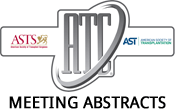2022 American Transplant Congress
A Model for Medical Device Innovation in Transplantation: Using the Biodesign Process to Address the Impact of Warm Ischemic Injury
1University of California San Francisco, San Francisco, CA, 2Stanford University, Palo Alto, CA
*Purpose: The impact of warming during second warm-ischemia (anastomosis) of kidney transplantation has been increasingly recognized in the literature. The outsized effect on delayed graft…2022 American Transplant Congress
Bioink Based on the DECM for 3D-Bioprinting of Bionic Pancreas – First Results of Animal
*Purpose: Tissue engineering is an interdisciplinary field involving activities based on two interrelated areas: developing new methods to repair, regenerate and replace damaged tissues and…2022 American Transplant Congress
Towards Bionic Organs: Biocompatibility Of Newly Developed Porcine Decm-based Hydrogels.
Foundation of Research and Science Development, Warsaw, Poland
*Purpose: There is a growing interest in fabrication of bioinks which on one hand biocompatible and on the other hand possess mechanical properties which would…2022 American Transplant Congress
Maturation and Evaluation of 3D Printed Bionic Pancreas with a Dedicated Bioreactor
*Purpose: The technology of 3D printing of bionic organs gives an opportunity to solve the problems of classical transplantology, such as the shortage of organs,…2022 American Transplant Congress
Optimization of Human Liver Organoid Model for Nonalcoholic Fatty Liver Disease and Nonalcoholic Steatohepatitis
*Purpose: The aim of our project is to develop an in vitro 3D human liver organoid (3D-HLO) model for studying nonalcoholic fatty liver disease (NAFLD)…2022 American Transplant Congress
Plasma from Patients with Primary Focal Segmental Glomerulosclerosis Induce Development of Sclerotic Glomeruli in Kidney Organoids
*Purpose: Primary focal segmental glomerulosclerosis (FSGS) is a kidney disorder resulting in end-stage renal disease that is associated with an elevated rate of recurrence after…2022 American Transplant Congress
Addressing the Organ Shortage, Improving Transplant Longevity, and Enabling Minimally Invasive Kidney Transplantation: Development of an Intraoperative Kidney Anastomosis Facilitation and Regelation Device
*Purpose: Second warm ischemia time (SWIT) of a renal allograft during anastomosis increases rates of delayed graft function and premature graft failure. In the setting…2022 American Transplant Congress
Engineered IL-2 Plus Calcineurin Inhibitor Synergistically Expands Regulatory T Cells Transduced with Engineered IL-2 Receptor and Facilitates Establishment of Transplantation Tolerance
*Purpose: Clinical trials for regulatory T cell (Treg) therapy in organ transplant has shown promising results. However, it is still under the debate which drugs…2022 American Transplant Congress
Immunometabolism of Regulatory T Cells Enhanced by Lipid Nanoparticles
*Purpose: Human regulatory T cell (Treg) metabolism is highly dependent upon a number of factors, including cholesterol obtained from circulating lipoproteins. We have developed high-density…2022 American Transplant Congress
Vitrification of Pancreatic Islets and Transplantation
1University of Minnesota, Minneapolis, MN, 2Mayo Clinic, Rochester, MN
*Purpose: A limitation to potential cure for diabetes through islet transplantation is insufficient islet equivalence (IEQ) from a single donor to achieve insulin independence in…
- 1
- 2
- 3
- …
- 9
- Next Page »
